- Home
- Thornton Wilder
The Eighth Day Page 2
The Eighth Day Read online
Page 2
It was the failure to establish a motive for the crime that aroused wide indignation. The prosecution advanced too many motives and no one of them convincing. Coaltown, however, was convinced that it knew why Ashley had killed Lansing and most of the members of the court were from Coaltown. Everyone knew it and no one mentioned it. Coaltown folk of the better sort do not talk to strangers. Ashley killed Lansing because Ashley was in love with Lansing’s wife, and the jury sent him to his death, firmly and unanimously, with what a Chicago paper called “shameless calm.” Old Judge Crittenden’s admonition to the jury on this point was particularly weighty; he enjoined them—with something approaching a wink of connivance—to perform their solemn duty, and they did. To out-of-town reporters the trial was a farce and it soon became a scandal in the upper Mississippi Valley. The defense raged, the newspapers sneered, telegrams rained upon the Governor’s mansion in Springfield, but Coaltown knew what it knew. This silence about the guilty relations between John Ashley and Eustacia Lansing did not proceed from any chivalrous desire to protect a lady’s good name; there was a solider foundation for silence than that. No witness ventured to voice the charge because no witness was in possession of the smallest evidence. Gossip had solidified into conviction as prejudice solidifies into self-evident truth.
Just at the moment when public outrage was at its height John Ashley escaped from his guards. Flight tends to be interpreted as an acknowledgment of guilt and questions concerning motive became irrelevant.
It is possible that the verdict might have been less severe if Ashley had behaved differently in court. He showed no signs of fear. He afforded no fascinating spectacle of mounting terror and remorse. He sat through the long trial listening serenely as though he expected the proceedings to satisfy his moderate curiosity as to who killed Breckenridge Lansing. But then, for Coaltown, he was an odd man. He was practically a foreigner—that is, he came from New York State and spoke in the way they speak there. His wife was German and spoke with a slight accent of her own. He seemed to have no ambition. He had worked for almost twenty years in the mines’ office on a very small salary—as small as the second-best-paid clergyman’s in town—in apparentment. He was odd through a very lack of striking characteristics. He was neither dark nor light, tall nor short, fat nor thin, bright nor dull. He had an agreeable enough presence, but one that seldom attracted a second glance. A Chicago reporter, at the beginning of the trial, repeatedly alluded to him as “our uninteresting hero.” (He changed his mind later—a man on trial for his life who exhibits no anxiety arouses interest.) Women liked Ashley, because he liked them and because he was an attentive listener; men—except for the foremen in the mine—paid him little attention, though something in his self-effacing silence aroused in them a constant attempt to impress him.
Breckenridge Lansing was big and blond. He crushed everyone’s hand in genial friendship. He laughed loudly; he did not restrain himself when he was in a rage. He was gregarious; he belonged to every lodge, fraternal order, and association that the town afforded. He loved the rituals: tears came to his eyes—manly tears; he wasn’t ashamed of them—when he swore for the hundredth time to “maintain friendship with the brothers until death” and “to live under God in virtue and to be prepared to lay down his life for his country.” It’s vows like that, by golly, that give meaning to a man’s life. He had his little weaknesses. He spent many an evening at those taverns up the River Road, not returning home until morning. This was not the behavior of an exemplary family man and Mrs. Lansing might have had some reason to resent it. But in public places—at the volunteer firemen’s picnic, at the school’s graduation exercises—he showered her with attentions, he broadly displayed his pride in her. It was generally known that he was incompetent as resident manager at the mines and that he seldom showed up there before eleven. As a father he had certainly failed in the rearing of two of his three children. George was held to be a “rowdy” and a “terror.” Anne was a winning child who won by tantrums and rudeness. But these little failings were understandable. Several of them were shared by the most esteemed citizens in town. Lansing was a likable man and good company. What a splendid trial it would have been if Lansing had shot Ashley! What a performance he would have put on! The town would have seen to it that he was first thoroughly frightened—cowering—and then acquitted him.
This unimportant case in a small town in southern Illinois might have been forgotten even sooner had it not been for the mysterious circumstances surrounding the convict’s escape. He did not raise a finger. He was rescued. Six men—dressed as railway porters, their faces blackened with burnt cork—entered the locked car. They smashed the hanging lanterns; without firing a shot or uttering a word they overcame the guards and carried the prisoner out of the train. Two of the guards fired once, but dared not continue for fear of killing one of their own number in the darkness. Who were these men who risked their lives to save John Ashley’s? Paid hirelings? Mrs. Ashley declared repeatedly to the representatives of the State’s Attorney’s office—the furious, humiliated police—that she had no idea who they were. Everything about the rescue was awe-inspiring—the strength, the skill, the precision, but above all the silence and the fact that the rescuers were unarmed. It was eerie; it was unearthly.
John Ashley’s trial and escape brought ridicule on the State of Illinois. Up to the time of the First World War—which started Americans moving about all over the country and changing their residences on a whim—every man, woman, and child believed that he or she lived in the best town in the best state in the best country in the world. This conviction filled them with a certain strength. It was reinforced by an unremitting depreciation of any neighboring town, state, or country. This pride in place was inculcated in children and the prides and humiliations of childhood are tenacious. Children applied the principle to the very streets on which they lived. You could hear them as they returned from school: “If I had to live on Oak Street, I’d die!” “Well, everybody knows that anybody who lives on Elm Street is craze-e-e, so there!” Colonel Stotz, the State’s Attorney for Illinois, was a leading citizen of the greatest state in the world’s greatest country. The dome of the State House (Abraham Lincoln’s State House) in which he held office was the visible symbol of justice, dignity, and order. The contempt poured upon Illinois as a result of the Ashley Case during his fourth and last term of office darkened his day at noon and opened a crack in the ground beneath his feet. He hated the name of Ashley and resolved to pursue the convict to the farthest corners of the earth.
From the Monday morning after Lansing’s death the Ashley children were withdrawn from school, much to the disappointment of their classmates. Only Sophia circulated in town, doing the shopping for her mother. Ella Gates spat in her face on the post office steps. Ashley forbade his daughters to attend the trial. Day after day, Roger—seventeen and a half—sat beside his mother in court, also frustrating his fellow townsmen of any spectacle of fear. As Roger said later, “Mama’s at her best when things are going badly.” She sat a few yards from the prisoner’s bench. It distressed her to realize that sleeplessness was robbing her cheeks of color. At eight-thirty every morning she scrubbed them long and roughly to induce a semblance of well-being and of unshakable confidence.
An additional odd fact about the Ashleys came to light during the trial: no relative of either John or Beata arrived in town to aid or comfort them.
In time the story entered legend and was retold more and more incorrectly. It was said that some thugs from New York had held up the train; they had been paid a thousand dollars each by Ashley’s lady love, the widow of the man he murdered. Or that Ashley, with the help of his son Roger, had shot his way out of a posse of eleven men. Even after the State’s Attorney’s office had exonerated John Ashley, there were many people to be found who would narrow their eyes and say knowingly: “There was a lot behind that affair that never came to light.” The Ashley children and the Lansing children left Coaltown, one by one. Then fir
st Mrs. Ashley, then Mrs. Lansing, moved to the Pacific Coast. It seemed as though time were gradually expunging the whole unhappy story as it had expunged so many others. But no!
About nine years later people began talking about the Ashley Case again. Newspapermen, ordinary citizens, even scientists took to visiting the periodical rooms in libraries to read the yellowing files of old newspapers. People were more and more interested in the “Ashley children”—each so distinguished in a different life-work. Everyone was interested in the “Ashley children” except the “Ashley children” themselves. They were the object of that particularly clamorous form of celebrity that surrounds those who are both ridiculed and admired, adored and hated. They were rendered increasingly conspicuous because they had called attention to themselves at so early an age and because they were vaguely associated with a background of tragedy and disgrace. It was generally recognized that they possessed a number of traits in common. Though only those who had known them in their early Coaltown years—Dr. Gillies, Eustacia Lansing, Olga Doubkov—knew the extent to which these were inherited from their parents, particularly from their father. They were without any competitive sense with its concomitants of envy and retaliation, though Lily and Roger were engaged in dog-eat-dog professions. They were without self-consciousness, had no deference whatever toward the opinion of others, and were without fear—though Constance spent over two years in jail, in six arrests in four countries, and Roger was burned in effigy at home and abroad. Lily and Constance had no vanity though they were among the most beautiful women of their time. All were without a sense of humor, though with the years they acquired a trenchancy of speech that resembled wit and were widely quoted. They were not self-regarding. Some who knew them best described them as being “abstract.” No wonder they puzzled their contemporaries and were variously charged with being ruthless, self-seeking, stony-hearted, hypocritical, and athirst for publicity. They would perhaps have aroused an even stronger antagonism had there not been something absurd about them, too—naïve, didactic, “small town.” All had big protruding ears (“swinging barn doors”) and big feet—Heaven’s gifts to caricaturists. When Constance—on her endless crusades, “Votes for Women,” “Refuges for Destitute Children,” “Rights of Married Women”—climbed the steps of a platform (she was particularly loved in India and Japan) gales of laughter would sweep the multitude; she never could understand why.
So it was that as early as 1910 and 1911 people began to study the records of the Ashley Case and to ask questions—frivolous or thoughtful questions—about John and Beata Ashley and their children, about Coaltown, about those old teasers Heredity and Environment, about gifts and talents, and destiny and chance.
This John Ashley—what was there in him (as in some hero in those old plays of the Greeks) that brought down upon him so mixed a portion of fate: unmerited punishment, a “miraculous” rescue, exile, and an illustrious progeny?
What was there in the ancestry and later in the home life of the Ashleys that fostered this energy of mind and spirit?
What was there in this Kangaheela Valley as geographical matrix, as spiritual climate, to shape such exceptional men and women?
Was there a connection between the catastrophe that befell both houses and these later developments? Are humiliation, injustice, suffering, destitution, and ostracism—are they blessings?
Nothing is more interesting than the inquiry as to how creativity operates in anyone, in everyone: mind, propelled by passion, imposing itself, building and unbuilding; mind—the latest-appearing manifestation of life—expressing itself in statesman and criminal, in poet and banker, in street cleaner and housewife, in father and mother—establishing order or spreading havoc; mind—condensing its energy in groups and nations, rising to an incandescence and then ebbing away exhausted; mind—enslaving and massacring or diffusing justice and beauty:
Pallas Athene’s Athens, like a lighthouse on a hill, sending forth beams that still illuminate men in council;
Palestine, for a thousand years, like a geyser in the sand, producing genius after genius, and soon there will be no one on earth who has not been affected by them.
Is there more and more of it, or less and less?
Is the brain neutral between destruction and beneficence?
Is it possible that there will someday be a “spiritualization” of the human animal?
It is absurd to compare our children of the Kangaheela Valley to the august examples of good and evil action I have referred to above (already in the middle of this century they are largely forgotten), but:
They are near,
They are accessible to our indiscreet observation.
The central portion of Coaltown is long and narrow, lying between two steep bluffs. Since its main street runs north to southeast, it receives little direct sunlight. Many of the citizens seldom see a sunrise or a sunset or more than a fragment of a constellation. At the northern end are the depot, the town hall, the courthouse, the Illinois Tavern, and the Ashley house, built long ago by Airlee MacGregor and called “The Elms”; at the southern end are the Memorial Park with its statue of a Union soldier, the cemetery, and the Breckenridge Lansing house, “St. Kitts”—named after the island in the Caribbean on which Eustacia Lansing was born. These two houses are the only ones in Coaltown possessing sufficient level space about them to be described as having “grounds.” An unhappy stream, the Kangaheela, flows through the valley on the eastern side of the main street; it widens into ponds behind both “The Elms” and “St. Kitts.” The town is larger than it appears to be. Since its center is confined within a narrow valley, the homes of many of its citizens are perched on the surrounding hills or line the roads that lead north and south. The miners live in communities of their own on Bluebell Ridge and Grimble Mountain. They have their company stores, their schools, and their churches. They seldom descend into town. Coaltown had expanded and shrunk several times during the nineteenth century. The mines had once given employment to as many as three thousand men and several hundred children. Waves of immigrants had settled briefly in the region and moved on—hunters and trappers, religious sects, miners from Silesia, and entire farming communities in search of good land. There were not a few abandoned churches and schoolhouses and cemeteries in the nearby hills and along the River Road. Dr. Gillies estimated that a hundred thousand persons had lived in the two counties; learning of the great Indian burial grounds near Goshen and Penniwick, he raised his figure.
There must have been a great shallow lake here to have produced all that sandstone, but the land rose and most of the water flowed off into the Ohio and the Mississippi. There must have been great forests to have produced all that coal and centuries of earthquakes to have lifted the hills and folded them over the forests like pancakes over jelly. The great cumbersome reptiles were unable to waddle away in time and left their imprints in stone—you can see them in the museum at Fort Barry. What stretches of time are required to complete the procession of a marsh to a forest. The professors have drawn up the time plan: so much for the grasses to furnish humus for the bushes; so much for the bushes to accommodate the trees; so much for the young of the oak family to take root under the grateful shade of the wild cherry and the maple, and to supplant them; so much for the white oak to replace the red; so much for the majestic entrance of the beech family, which has been waiting for its propitious hour—the war of the saplings, so to speak. The internecine warfare of the plants was joined by that of the animals. The blat of the deer struck terror in the forest as the great cats sank their teeth in the jugular vein; the hawk bore skyward the snake that held a fieldmouse in its jaws.
Then man came.
One of the finest “turtle mounds” in all the Algonquin region is near Coaltown, in Goshen, and there are three superb “snake mounds” to the north. In our time any boy with spirit in him had his collection of Indian arrowheads, pestles, and axes. The professors disagree as to the reason for the several massacres, for these were notably pe
ace-loving tribes. One scholar attributes them to the custom of exogamic marriage—raids on the tribes of other totems in order to steal brides for their young braves. Another, however, holds that these aggressions were prompted by economic needs; the Bleu Barrés had depleted the game within their territory and were driven to encroach upon the Kangaheelas’ land. Whatever the reason, an examination of the skeletons in the various necropolises reveals an appalling amount of mayhem.
In 1907, long after these tribes were thought to be extinct, a wandering ethnologist came upon a small community of Kangaheelas living and coughing in shanties at Gilchrist’s Ferry on the Mississippi, sixty miles west of Coaltown. It was hard to understand how they lived; a few sold ill-made moccasins, pipes, arrows, and beadwork from roadside stands. One night, for whiskey, an old man told the story of his people. They were the envy of the other nations for the elegance of their dress, the splendor of their dances (Kangaheela means “sacred dance floor”), their wisdom, and for their proficiency in divination. Every male from his eighteenth year could repeat without mistake the Book of Beginnings and Endings, a recital that filled two nights and days interrupted by dances. The Kangaheelas were famous for their hospitality; places were reserved for guests from the other nations who may have understood a portion of the text. The council fire lit up the faces of thousands seated about the sacred dance floor. Glorious was the first night—the story of creation with its exhausting account of the warfare between the sun and darkness. This was followed by an account of the birth of the first man from the All-Father’s nostrils—the first Kangaheela. A morning was given over to a catalogue of the laws and tabus he had instituted—matter so old that at times the words were unintelligible and the intention unclear. By noon the reciter entered upon the chronicle and genealogy of heroes and traitors—eight hours long. Just before the second midnight there was delivered the Book of Hard Prophecies given to us by the All-Father, three hours of humiliation and bitterness. The sins of men had turned the beauty of the earth into a midden. Brother had slain brother. The sacred duty of generation had been made a sport of the unthinking. The All-Father carries in His heart all the nations of the forest, but they will creep like the snake; their numbers will be reduced; the rejoicing at the birth of a child will be feigned.

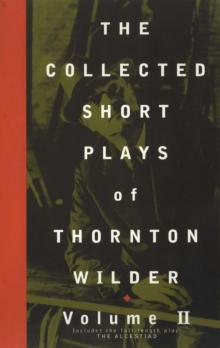 The Collected Short Plays of Thornton Wilder, Volume II
The Collected Short Plays of Thornton Wilder, Volume II Penelope Niven
Penelope Niven The Selected Letters of Thornton Wilder
The Selected Letters of Thornton Wilder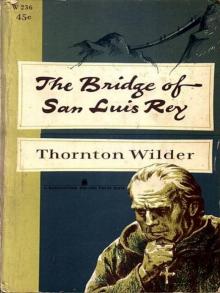 The Bridge of San Luis Rey
The Bridge of San Luis Rey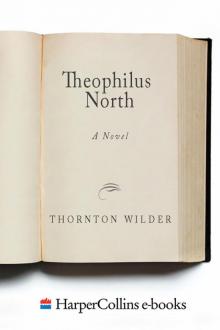 Theophilus North
Theophilus North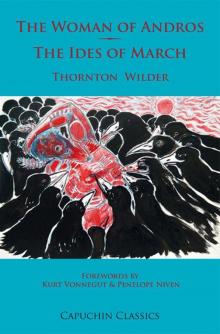 The Woman of Andros / the Ides of March
The Woman of Andros / the Ides of March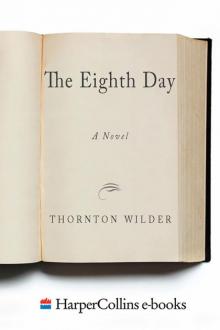 The Eighth Day
The Eighth Day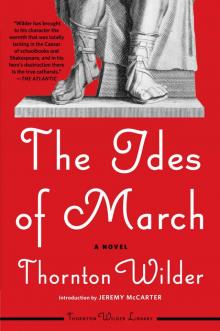 The Ides of March
The Ides of March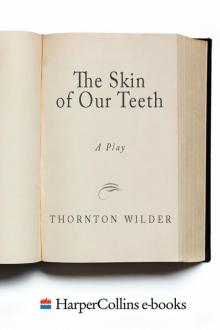 The Skin of Our Teeth
The Skin of Our Teeth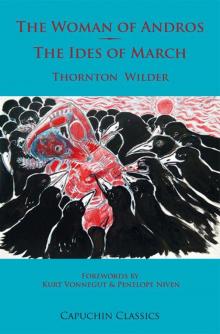 The Woman of Andros and The Ides of March
The Woman of Andros and The Ides of March